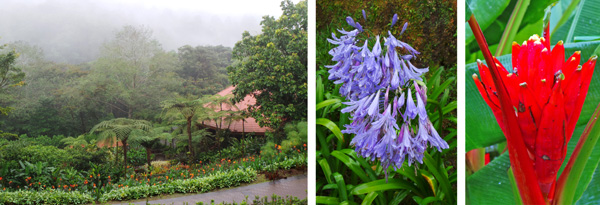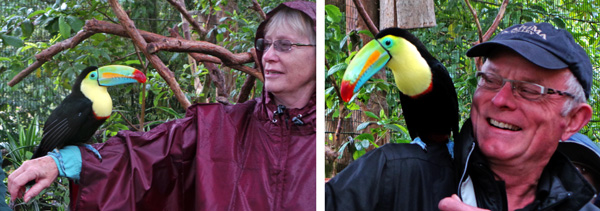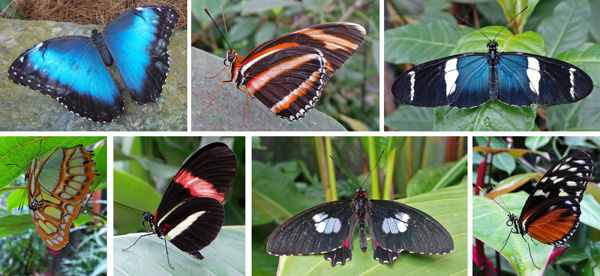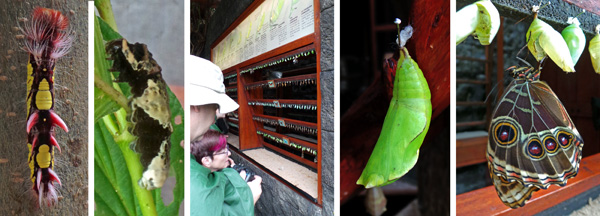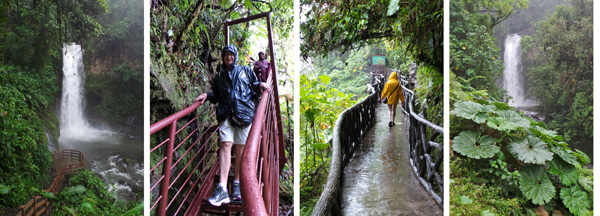It was sunny when we left the Central Valley this morning, but the clouds on the mountain where we were headed to didn’t give us much optimism for the weather we’d encounter up there. Sure enough, it was foggy and raining lightly when we got to La Paz Waterfall Gardens. This nicely developed park on the eastern slope of the Continental Divide features collections of native animals of the region, the adjacent natural waterfalls, and beautifully landscaped grounds, giving visitors a chance to see many things up close that otherwise might be missed.
View of the Gardens from the entrance (L); agapanthus flowers (C); and scarlet banana, Musa coccinea (R).
Of course it’s nicer to visit when sunny, but there is still a lot to see in the rain. After getting our entrance bracelets and using the restrooms (which are worth visiting just for the interesting sinks), everyone geared up with rain jackets, ponchos and/or umbrellas, and we slowly made our way down the steps toward the aviary in the rain. The rain had put a damper on bird activity, so we didn’t see as many birds as typically are seen in the free-flight area (all of which are rescued, none captured from the wild), but we did enjoy the black guans that flew over to greet us, one even jumping onto the railing at the edge of the overlook despite all the people and some of the group saw the blue-crowned motmot. The raptors – including a gray hawk and crested caracara – and the parrots – including scarlet macaws – are in their own individual large cages, and were easier to spot.
One of the highlights was the toucan encounter enclosure, where an attendant facilitated the large keel-billed toucan to hop onto each person’s arm or shoulder in turn. There were several black-mandibled toucans flying around as well, and it was easy to get up close to them.
A keel-billed toucan sits on Cindy’s arm (L) and Dave is thrilled to have the bird sit on his shoulder (R).
Judy photographs one of many toucans in the enclosure (L); black-mandibled toucan (C); and driver Ricardo gets to have a toucan sit on his arm (R).
The butterfly house is an educational exhibit that allows visitors to see many native tropical butterflies up close. They are all raised on site, and once they emerge from the pupae hanging in large racks, they are free to fly around in the large, temperature and humidity-controlled building. Even though the butterfly house has a roof over it, the butterflies weren’t very active either, but that wasn’t all bad. Instead of them flying frantically around the large enclosure, most were sitting patiently on flowers or foliage, making taking their pictures easier. We marveled at all the different types, including red postman, banded orange, several longwings, blue morphos and many others.
p row (L-R): blue morpho, banded orange underside (Dryadula phaetusa), and Heliconius sara.
Bottom row (L-R): Malachite, postman (Heliconius erato petiverana), cattleheart butterfly, Paridessp, and Hecale longwing (Heliconius hecale).
There were also a few plants with caterpillars on them, and racks filled with chrysalises, many empty shells with the butterflies already eclosed, but others in various stages of maturity and a few with the recently-emerged butterflies still hanging down expanding their wings. Interpretive signage provides a lot of information on their life cycle, the rearing process, and conservation of butterflies.
Larva of morpho (L) and another moth (LC); racks of pupae (C); pupa of Opsiphanes tamarindi tamarindi (RC); and recently eclosed morpho drying its wings (R).
Because of the weather the monkeys were huddled together under their shelters rather than out running and swinging around their big cages, but a little rain wasn’t going to stop the hummingbirds. Many different species of the little birds were zooming in to use the red feeders strung up all over the hummingbird garden. A crowd of tourists made it a little challenging to watch or photograph the zippy little birds. Large, purple violet sabrewings chased off the smaller purple-throated mountain gems and copper-headed hummingbirds, while the green crowned brilliants held their ground, along with the occasional green hermit, green thorntail, and blackbellied hummingbird, among others.
Ian takes pictures while Sherry and Dave walk through the hummingbird garden (L); male purple-throated mountain gem (LC); male green crowned brilliant (RC); and violet sabrewing (R).
You can see a variety of Costa Rican snakes in cages in the snake house, both leaf and poison dart frogs in the ranarium (rana is the Spanish word for frog), and orchids displayed in a small outdoor pavilion.
Giant parrotsnake (L), sleeping red-eyed leaf frog (LC), strawberry poison dart frog (RC), and black and green poison dart frog (R).
Several types of felines, each in their own cages – mostly napping in their nest boxes in their large, landscaped enclosures – can be seen in the jungle cat exhibit.
The pair of oxen hitched to their brightly painted oxcart were looking rather bored in their small covered shelter, rather than out walking around like they would be if the weather was better.
We then headed down the steep slope on the nicely paved, stepped trail to the waterfalls. It was wet and dripping under the high tree canopy as we made our way to the river, where the falls were full and roaring loudly with all this rain. The rain had picked up again as we made our way along the couple kilometer trails – including lots of steps – to see four different falls cascading over precipices up to 125 feet high. But with the steady rain most people didn’t linger on the trail, and we were glad to get back to the bus and return down the mountain to the Central Valley where it was only partly cloudy.

